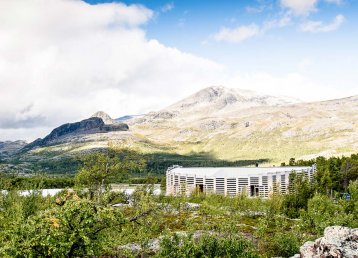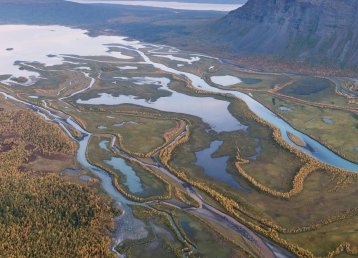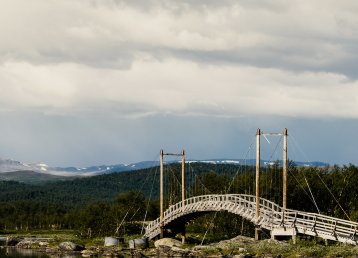Five in the morning, on a clear day in July. The view from Vákkudakvárátja, just above the STF cabin in Vákkudavarre, towards Áhkká, is glorious indeed. Still, the word glorious is not enough to describe the landscape that extends out in front of you. Could beauty and grandeur be almost deafening? Well, it makes me dizzy from where I am standing. Not just the view, there are other senses at play here. The quiet stillness and the scents of summer nights. For once the reservoir, Rijtsemjávrre, is calm as a mirror and the huge mountain range is reflected in all its splendour.
There is nowhere in Sweden where this kind of dramatic, nearly Alpine environment is as easily accessible as along the ‘Way West’ – a 145-kilometre-long, paved cul-de-sac that stretches from Luspebryggan on the road E45 to Ritsem in Gällivare municipality. The road leads straight into the heart of Laponia, one of Sweden’s 15 World Heritages. As we are writing this, in the end of 2022, there are 1,157 Word Heritage Sites and out of those, only 39 are designated as such for both their culture and their nature. Laponia in Swedish Lapand is one of them. This is something Lennart Pittja, the owner of award-winning glamping Sápmi Nature, loves to talk about.
“In a way it makes me extra proud that reindeer herding and the Sámi way of life in Laponia is, in fact, traditional knowledge of universal importance.”
Also read
A journey into all things SamiUniversal value
In the beginning the application to become a World Heritage specified the reserve Sjaunja, but a marshland with plenty of mosquitoes traversed by the Inlandsbanan railway was not enough for UNESCO. Then the four national parks were added, an area measuring some 9,400 square kilometres filled with the most beautiful nature you can imagine – but that was not enough either. UNESCO, the organisation in charge of World Heritage applications, did not agree that the nature here was of universal value to mankind. But when reindeer herding and Sámi culture were mentioned – as this is one of the last big areas in Europe where people seasonally migrate with their animals – the value of the place became clear.
The reindeer is central to Sámi life, and in this area there has been a working migration route between summer and winter grazing for a long time. So, when Laponia was going to be protected for its culture, nature was brought along for the ride. The journey was not always in a straight line, but the process itself is very interesting, and something we will get back to.
A hymn to home
Lennart Pittja runs the award-winning eco-lodge Sápmi Nature Camp in the Laponia World Heritage in Swedish Lapland, on the grounds his sámi reindeer herding community Unna Tjerusj has inhabited for generations.
The same pattern
Lennart Pittja’s camp is in Nábbreluokta, not far from where Gällivare’s first church was built in 1650. The church burnt down shortly afterwards, the introduction of Christianity in the area had its setbacks. Lennart belongs to the Sámi association Unna Tjerusj, ‘the little village’. The reindeer herding land belonging to the association follows the northern part of Stuor Julevu (the Greater Lule River). Unna Tjerusj is one of nine Sámi associations whose reindeer herding lands are part of World Heritage Laponia. The other eight are: Baste čearru, Sirges, Jåhkågaska tjiellde, Tuorpon, Luokta-Mávas, Slakka, Udtja and Gällivare.
“It makes me extra proud that reindeer herding and the Sámi way of life in Laponia is, in fact, traditional knowledge of universal importance”
For most of us, it would be easier to come up with the names of eight North American Native tribes. This probably has less to do with us not being interested, and more with the fact that in school we were never given the opportunity to learn about our own native people. The story above, about the application to UNESCO, follows the same pattern. To Swedes, nature was the main thing, what first came to mind when applying; to the world as a whole, traditional knowledge was what was irreplaceable and of universal value.
In our midst
From the beginning, the first inhabitants followed the movements of the reindeer herd in the area. And during the years, this gave rise to a particular lifestyle, whether the reindeer were wild or domesticated. The Sámi and the reindeer learnt to live side by side. A reindeer herding area is the area that the reindeer need as their grazing land.
A week or so before the Jåhkåmåhke márnán, the Jokkmokk Market, I speak with Per Kuhmunen. For more than 50 years he has walked through this world-famous event with his reindeer caravan. Per says that when he started at the nomadic school he protested loudly when his teacher claimed the Earth was round. Per knew, from his own experience, that it was elliptical and also how it stretched out between Vaisaluokta and Porjus, the migration cycle his family undertook every year with their reindeer, from the summer grazing land to the winter grazing land and back. Think about that when you hear the word ‘nomad’ – nothing is far away or somewhere else. They are in our midst, in the state someone once decided to name Sweden. I think about this conversation, Per feding his tame reindeer with lichen behind his house in Jokkmokk, waiting for the market to start. Once upon a time, his Universe was smaller than World Heritage Laponia. Today the world is a lot bigger, but Per Kuhmunen is still not entirely sure it is any better.
In terms of surface, by comparison, the World Heritage more or less equals the holiday destination Cyprus. Laponia’s borders hold four national parks – Muttos, Sarek, Badjelánnda and Stuor Muorke – and nature reserves Stubbá and Sjávnja, but also rich natural areas such as Ráhpaäno and Sulidälbmá. What kind of traces actually remain of the traditional livelihood in this area, sometimes referred to as ‘Europe’s last wilderness’?
Also read
The national parks
Smörboll (Butter ball)
The yellow flowers reminding of giant buttercups has given Trollius europaeus the Swedish name Smörboll (Butter ball).
From prey to property
Anna Rimpi worked as an archaeologist in Laponia for eight years. But now she is doing a PhD on trapping pits and hunting traditions. Anna says there are extensive human traces in Laponia.
“And since there is a massive number of trapping pits, the conclusion is that it was worthwhile.”
She states that these traces are present from around 5,000 BC to the Middle Ages. Trapping pits were used both for elk and reindeer, but here in Laponia reindeer was the main target. Reindeer used to be wild, once upon a time. There was also a transitional period when reindeer were both hunted and domesticated, and in our time it is all about herding and the reindeer has transitioned from prey to property.
"Today approximately a third of the planet is inhabited by indigenous people"
Anna Rimpi is from Vitå, closer to the coast. Her own idea of Laponia used to be that classic image of the mountains, but once the area and the administration was her workplace, her view changed.
“I’m extremely fond of just travelling through the landscape. But I have to admit that because of my profession I can’t help looking for the predictable wandering routes that must have been essential to the indigenous people and their everyday life. Suddenly, walking along, I get that feeling of ‘this is where it should be’. And often, I am right and come across traces of the indigenous people’s hardship.”
The trapping pits might be the most apparent monument Laponia’s first inhabitants left behind. They were large and took a lot of work, and that means the ravages of time have not been able to hide them.
“Unfortunately other remains along the Lule River, like people’s settlements, more or less disappeared when the hydroelectric power stations were built and the water was dammed. When it comes to settlements, we can simply state that the archive of knowledge that we had, has pretty much burnt to the ground.”
Thanks to Anna Rimpi’s stocktaking a lot more trapping pits have been discovered, even 500 metres above sea level. Still we keep learning more and more about Laponia’s history.
Lifelong dedication
Ájtte, the Swedish Mountain and Sámi Museum in Jokkmokk, is another good place to start if you want to know more about Laponia. There are entrances and information centres to the great world heritage space in Gällivare and at Naturum in Stuor Mourke/Stora Sjöfallet, and Ájtte, with its alpine botanical garden, is an amazing introduction in every way. The museum’s exhibition on handicraft is unique, and so is Fjällträdgården, the alpine botanical garden, and its recreation of the habitats found in Laponia.
In Fjällträdgården you will also find one of Axel Hamberg’s houses. Hamberg was a Swedish scientist who dedicated his life to research in Sarek. In 1895, when Hamberg was 32 years old, he was tasked with taking an inventory of glaciers in Sarek. He went on to make 35 summer visits and six winter visits to Sarek. The glacier inventory grew and became a mapping project for the entire area. Maps were scarce at best and Hamberg had to draw his own. He concluded his work on the map by stating “performing these measurements has been a never-ending struggle filled with difficulties”.
After the first winter, when Hamberg and his colleagues lived in a hut that did not quite manage to keep the heat in, he decided to build several cabins at different spots in Sarek. The five buildings, using his own patented design, were built as wooden structures clad with sheet metal and then insulated with cotton. They were located in Pårek, Pårtetjåkko, Litnok, Skårkas and Tjågnoris. The cabin from Tjågnoris has been moved to the alpine botanical garden, renovated and turned into an exciting exhibition.
Hiking Kungsleden
Kungsleden, the King’s trail runs from Hemavan to Abisko in the Swedish mountains amd is one of the world’s most popular hiking trails. On its way, it passes the summer grounds of fifteen “samebyar” (Sámi communities), organized through the reindeer husbandry act.

Ájtte
The Swedish Mountain and Sámi Museum in Jokkmokk, is another good place to start if you want to know more about Laponia.
It takes time
Today approximately a third of the planet is inhabited by indigenous people. They make up 5% of the world’s population but act as protectors of 80% of the world’s biodiversity. The viewpoint of indigenous people was a recurring theme during the World Economic Forum in Davos 2022.
Fast transactions, or decisions made based on yet another quarterly report is not a sustainable solution. Instead, many indigenous people around the world live by the seven-generation principle. Meaning that the decisions we make now will affect seven generations to come. A way more sustainable viewpoint. Laponia was established as a World Heritage in 1996 and the nomination process had been going on for several years before that. Once it became a World Heritage, the next question was how to manage it. ‘Tjuottjodit’ is the Lule Sámi word for administration. The organisation Laponiatjuottjudus, see laponia.nu, is simply ‘the administration for Laponia’.
The organisation Laponiatjuottjudus is the administration that formally took over management of the World Heritage from the county board in 2013. It is made up of representatives from all nine Sámi associations in the area, from the municipalities Jokkmokk and Gällivare, and from the Swedish Environmental Protection Agency and the county board. One of the unique qualities of the decision-making in Laponiatjuottjudus is that decisions are taken by consensus. It is no good if 12 out of 13 think one thing. Everyone has to agree on a decision. It takes time.
Also read
The higher landOur country
The timeline, from a World Heritage appointed by UNESCO to a functioning entity, was no quick process. Bernt Wennström, who used to work for Gällivare municipality but is now retired, says being part of this process was something unique.
“UNESCO demanded both a management plan and a management organisation, of course.”
Around the turn of the century the county board had drafted a plan, but all nine Sámi communities thought it was not good enough. With that, we had to roll up our sleeves and create something that would last. The Sámi communities’ program for Laponia was later named ‘Mijá ednam’ – Our country.
Bernt and many others came from the public side, where majority rule was the norm – quick and rational were the guiding principles – and arrived in one where the participants took their time to make sure that everyone would agree.
“In that sense, the Laponia process was transformative. Just the fact that the Sámi communities decided that decisions would be taken by consensus was something new. The process taught me a lot. Sometimes time needs to be factored in to make sure the right decisions are made. Drinking coffee and having a chat fills a function.”
With the funding awarded by the government, the idea was that the process would be finished in three years. But it took practically twice that time, and the government had to award further funds. What was unique, apart from the consensus and the permanent Sámi chairmanship of the board, was also that local actors, nearly 100 of them, were invited to a consultation – ‘rádedibme’ in Sámi. These consultations still take place twice a year. There was also the fact that as a result of the process, an organisation outside of the Swedish Environmental Protection Agency now manages national parks. In Sweden, this is not the norm.
“No matter how you look at it”, says Bernt, “the Laponia process has taught me that the decision method using consensus is a very potent method. It takes time, but the decisions are firm.”
Also read
The eight seasonsSometimes unforgiving
The way west is a comfortable way of travelling into the World Heritage, and to Stuor Muorke/Stora Sjöfallet national park. To reach many other places you have to put on your hiking boots and put one foot in front of the other to get there. Naturum, at Stora Sjöfallet, is a must-see. Hiking routes for day trips are found from the Way West out to many sights in the national park. Stora Sjöfallet Mountain Lodge is a great accommodation, just like the famous Saltoluokta mountain station on Kungsleden, the King’s Trail.
Seven of Sweden’s twelve 2,000-metre peaks are in Laponia. Together with Giebmegáisse, Sarek is Sweden’s alpine heart. But to get to the peaks in Sarek you need a whole other level of grit than for Sweden’s highest peak, because Sarek is a vast, wild landscape. Sometimes unforgiving. You better come prepared.
Muttos national park is the protected forest land. If you stop along the E45 and jog up to the viewpoint at Oarjemus Stubbá, you are not only conquering the highest peak in the Muttos national park, you are also awarded with a gorgeous view of the vast forest land.
In the southern part of the park, you will find the famous waterfall Muttosagahtjaldak. The fourth national park in Laponia is Badjelánnda, which translates as ‘the higher land’. Up at lake Virihávrre, by the settlement in Staloluokta that Linné visited during his journey Iter Lapponicum in 1732, it is easy to understand the expression higher land. Air and ground, sky and water, all joined together in yet another pristine view. This is your time too, in Mijá ednam, even if you know it is just temporarily yours.


























